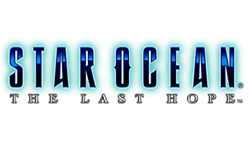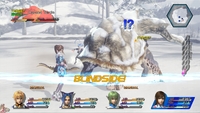|
|

|
PLATFORM
|
Xbox 360
|
BATTLE SYSTEM
|

|
INTERACTION
|

|
ORIGINALITY
|

|
STORY
|

|
MUSIC & SOUND
|

|
VISUALS
|

|
CHALLENGE
|
Adjustable
|
COMPLETION TIME
|
20-40 Hours
|
|
OVERALL

|
+ Fantastic battle system.
+ Complex crafting system...
- ...hampered by inaccessibility.
- Ridiculously long cutscenes.
- Horrible dialogue and voice acting.
- Unnecessarily enormous areas.
|
Click here for scoring definitions
|
|
|
The past few months have seen me playing a lot of Star Ocean. With Star Ocean: First Departure late last year, Second Evolution earlier this year, and a replay of Till the End of Time in between, the completion of Star Ocean: The Last Hope puts all four games in my completed pile in a mere six month time frame, and that experience has given me a pretty hefty appreciation for what the series does well, but also where it's lacking. As the latest entry in the series, The Last Hope has a lot to live up to. Unfortunately, its fantastic battle system simply cannot make up for the game's follies in virtually every other area, making it a rather disappointing addition to the series.
The game's focus is the battle system, so it's quite good that Star Ocean: The Last Hope has truly addictive, engaging combat. Like all games in the series, battles play out in real time with the player in control of a single character. Three other characters also participate in battle, controlled by some decent AI, though lacking customization options. Players can launch basic attacks, use skills bound to the trigger buttons, and open a battle menu to select spells, items, or change tactics and equipment, making its basic structure very similar to First Departure and Second Evolution. The Last Hope adds several new functions to combat, however, that make it a much more enjoyable and strategic experience.
The first of these features is the simple ability to dodge by pressing the B button and holding down the analog stick. This simple yet elegant functionality, an action game staple, allows the player to rapidly avoid incoming attacks, which does a lot for making combat less button-mashy. The dodge functionality can be furthered by holding down the B button for roughly a second, which activates the new blindsiding feature, easily the most useful addition to the Star Ocean gameplay. While charging, the player can push the analog stick in any direction, which causes the game to cut to a slow motion view of the character leaping aside and rushing to get behind the enemy. Once the animation is complete, not only will the enemy have lost sight of the player, but every attack landed on it will be a critical hit.
The Last Hope also introduces Rush mode, which functions much like limit breaks of Final Fantasy fame. By dealing and taking damage, the Rush gauge charges, and once activated allows the character to avoid being knocked down by enemy attacks as well as deal critical strikes without blindsiding. Players can also activate a special skill combo using Rush mode, which enables a series of extremely simple mini-games to have multiple characters use several skills in succession, dealing huge amounts of damage. Unfortunately, Rush mode is more of an AI-specialty, as players will likely find their allies and enemies using it far more often than they will. Luckily, Star Ocean: The Last Hope also allows each character to specialize in either blindsiding or Rush mode, increasing relevant stats and adding special effects to each ability as they increase in strength.
 Blindsiding is a double-whammy: avoid enemy attacks while dealing critical hits!
Blindsiding is a double-whammy: avoid enemy attacks while dealing critical hits!
|
|
Character customization is another area in which Star Ocean shines. Characters gain skill points as they level up, which can be distributed to improve combat and non-combat abilities. Each character has a crafting specialty to level up, as well as dozens of skills, spells, and passive abilities to improve. As the player explores the world and performs various non-combat actions, such as opening treasure chests, completing sidequests, or removing barriers, skill points are also added to a party-wide pool that can be spent on any character and also be used for item creation. Using this singular point system to cover all areas of character development works quite well, keeping things simple and straightforward while at the same time allowing the player to customize each character as he sees fit.
Unfortunately, that is about where the praise for The Last Hope ends. The rest of the game is a shambled trainwreck of poor level design, disparate graphical styles, and shoddy localization. I suppose we should begin with the item creation system. First off, the system itself is actually very good in concept. Taking the best ideas from the first two Star Ocean titles and combining them with the best elements of Till the End of Time, item creation is very simple to use. Each character is proficient in one of eight types of crafting, and by placing each character into production lines a la Till the End of Time, they will generate new recipes at a cost of one party SP per revolution of the timer. Once a recipe is created, the item can be created ad infinitum with no risk of failure so long as the player has the correct component items. Synthesis, introduced in Till the End of Time, also returns with The Last Hope, but this time not bogged down by insane costs and pointless material requirements. Furthermore, virtually all the items in the game, even food and otherwise worthless consumables, have different attributes that can be synthesized onto weapons, making it very easy to experiment with.
This would be terrific, if it were at all accessible. For some unknown reason, tri-Ace thought it would be a good idea to make item creation only available while on board the player's ship, an area that the player isn't likely to spend very much time in. This is due to the absolutely atrocious level design coupled with the complete lack of any form of quick travel. To put it simply, the levels are enormous, and unnecessarily so. It seems as if tri-Ace wanted to create gigantic areas to explore, but unfortunately, they forgot to put anything there to find. There are no extra characters, no sidequests or events, no hidden dungeons or bosses, nothing but a handful of treasure chests. To make this even more laughable, early in the game a character learns a skill called Treasure Sense, which shows the location of all treasure chests on the mini-map, making exploration completely unnecessary. To clarify, that isn't to say that there aren't side quests or hidden dungeons and bosses at all, it's that they aren't discovered by exploring these massive worlds. Sidequests are all localized within the comparitively tiny towns, and the bonus dungeons either require the game to already be cleared or the player to return to a planet and re-explore after the story events have already taken place.
These massive environments and a lack of any quick way back to the ship makes returning for item creation something of an irritation, and most players won't find it worth their time. To further inconvenience the player, at no point during the game will one ever be transported back to town after a dungeon. No, instead the player must trek back through several lengthy areas that were already visited in order to continue with the game. It certainly doesn't help, either, that save points are ridiculously far apart, generally taking more than an hour to go from one to another.
 The single most annoying character ever created in a video game.
The single most annoying character ever created in a video game.
|
|
The problems mount from there, as in between these enormous areas, the player can expect to be bombarded by insanely lengthy cutscenes, and do not mistake just how lengthy they are. Without exaggerating, most are at least half an hour long, and some push the hour mark. At least once per scene, and often several, the player can expect it to pause unexpectedly when the controller shuts itself off to preserve battery life. These cutscenes are atrocious, as the dialogue is weak and repetitious in that special way only JRPGs can pull off (but worse than normal), and the voice acting is equally abysmal. Occasionally the voicing does come off well, but certain characters (Lymle and Sarah) are awful and grating throughout. No character is without some bad moments.
The awkward nature of the voice and dialogue is only enhanced by the awkward design of the character models. Unsure of whether to create realistic or anime-styled graphics, Star Ocean: The Last Hope features character models that are a blend of the two, and the result is undeniably creepy. Their faces are too smooth to be real and too textured to be cartoony, their mouths are modeled in a realistic fashion and yet attempt to perform overexaggerated anime facial expressions, and their animations just seem unnatural. These bizarre hybrid models give every cutscene an unsettling tone, and it becomes extremely distracting. It seems very strange that tri-Ace would attempt to bring realism into the game at all, considering that the entire story is written like a typical anime. Had the game gone with a cel-shaded or even simply a more traditional model style, it's possible that these scenes might not have been as terrible as they are in their current state.
The environments, at least, are quite beautiful, although some of the dungeons do get a bit repetitive. In fact, any graphics not involving humanoid characters are generally quite spectacular. The story itself is also fairly good, despite the poorly written dialogue and certain obnoxious characters. The plot follows Edge Maverick as he ventures out as part of Earth's first mission into space, following a devastating nuclear war that left the surface of the planet uninhabitable. After his ship is forced to make an emergency landing on its destination planet, he soon finds himself commanding the SRF-003 Calnus as he and his rag-tag crew of friends and aliens explore the galaxy and work to stop a power that threatens the entire universe. To tri-Ace's credit, they certainly took many of the complaints about the first three Star Ocean titles to heart, as in this iteration they have crafted a story that truly captures the game's name. Players can expect to journey to more than a half dozen different planets over the course of the game, including one that fans of First Departure will be readily familiar with. The ending is also solid, tying together the events of the entire game, even ones that seemed meaningless at the time.
Star Ocean: The Last Hope's drawing power is really its battle system and little else. Despite a solid plot and strong item creation, the shoddy localization and terrible level design mar the experience beyond salvaging. The game's saving grace is the fact that cutscenes can be skipped, the process of which is followed by a brief text summary of what occurred, meaning that players who get fed up with the length or quality can simply skip through and get back to the gameplay. The Last Hope should take most players roughly forty hours to complete, but keep in mind that a significant portion of that is spent watching cutscenes. Skipping those, the game is likely completable in less than thirty. It's sad to see tri-Ace dropping the ball so horribly with this console generation, first with Infinite Undiscovery and now with Star Ocean: The Last Hope. If The Last Hope was theirs, the company may be in trouble. This reviewer, at least, will be looking at their future games a bit more cautiously.
Review Archives
|









